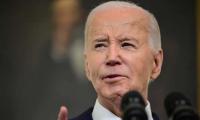Karachi will have the first ever transport system in Pakistan to use biomethane produced from animal waste as a fuel resource for the 213-bus fleet of the Red Line Bus Rapid Transit (BRT). The use of biomethane will also significantly reduce the carbon emission level in the city.
This was told at a conference held on Thursday at a hotel organised by the Asian Development Bank (ADB) in collaboration with the Sindh government, UN Green Climate Fund (GCF), Asian Infrastructure Investment Bank (AIIB) and Agence Française de Développement (AFD), which are the financiers of the Red Line project.
The BRT project has been renamed as the Karachi Breeze Red Line Project which is approximately a 29-kilometre corridor, extending from Model Colony in Malir in the northeast of the port city to Mazar-e-Quaid and Jinnah Avenue in its southwest, where it will intersect at Numaish with the Green Line corridor that is currently under construction.
The route of the Red Line will pass through 13 major intersections and a total of 24 bus stops will be located along it where entry and exit points will be provided. Ten overheads and seven underpasses have also been included in the BRT’s plan.
Separate consultants have been hired for the three tasks of the operational design, detail design, and institutional development and capacity building of the project.
The operational design is being drafted by the Exponent Engineering PVT Ltd, while the detail design is being devised by the Mott MacDonald Pakistan (MMP).
The institutional development and capacity building has been undertaken by the National Engineering Services Pakistan (Nespak) and the Integrated Transport Planning Limited.
The Red Line project is to be implemented by the Sindh government and its cost has been estimated at Rs78.384 billion. As many as 300,000 people are expected to use the bus corridor daily.
According to the feasibility study of the Red Line, the project will have its own dedicated biogas plant located in Landhi Cattle Colony, where 2,000 tons of cattle waste will be used to produce 60,000 Nm3 per day of biogas. The biogas plant will deliver 11 tons per day of compressed biomethane gas (CBG) to the bus fleet, increasing to 17 tons over the life of the BRT line as its demand would increase with the passage of time.
Giving a detailed overview on the project, ADB Principal Urban Development Specialist David Margonsztern said the Red Line is half a billion project sponsored by the ADB, AIIB and AFD and it is the first transport project ever approved for additional funding – including a $12 million grant – by the Green Climate Fund (GCF).
As for the project’s financing, he told the conference that the ADB is providing $235 million loan for the project, while the AFD will provide $71.8 million for civil works and equipment and the GCF will provide $37.3 million for the biogas plant and incremental cost for green fuel technology and an additional grant of $11.8 million for lane strip pavement for BRT lanes, bioswales, etc. The Sindh government’s share in the project’s cost is $75.5 million for utility relocation, taxes and resettlement cost.
The project is expected to prevent emission of 245,000 tons of carbon dioxide every year. “This is a very large amount,” he stressed. Commenting on the operation design of the project, he said the Red Line BRT will be a subsidy-free operation system, which means all the subsidy will be frontloaded into the infrastructure. “Once the system opens, we hope it will not require additional subsidies to operate.”
The operation and management cost, according to the ADB specialist, could be covered through revenues generated from the system. Sharing their revenue model, he explained how the revenue will be collected from bus fares, bicycle sharing system, property management, advertising and other avenues.
“All these revenues will go into the firm management company, most probably, a local bank. This bank will redistribute all the revenue among all the private sector operator of the system,” he said and added that they even renamed the project to Karachi Breeze Red Line Project keeping the revenue prospects in mind.
“This name came up after a very long consultation with civil society groups,” he said. The revenue can be increased by opting for the third generation system BRT. In the rest of Pakistan, there is mostly first or second generation BRT system. “This means that the buses run back and forth in the dedicated infrastructure – that’s the first generation – and when we add the feeder services it becomes the second generation,” he explained, adding that even in the second generation passengers still have to move between the feeder services.
While in the third generation BRT system, different bus services are multiplied within the segregated corridor and buses are loaded depending on their routes. “Buses can travel on a certain section of a corridor and then exit from it to serve other areas of the city,” he explained, adding that with this facility, they expect some 320,000 passengers using the service every day and this is three times larger than the number of passengers in Punjab or Islamabad’s BRTs.
There will be different sizes of buses in the Red Line BRT – nine-metre, 12-metre and 18-metre. “The 18-metre services will remain within the dedicated corridor infrastructure,” he said. To make the commute easy to and fro from the Red Line BRT’s bus station, the planners have introduced a bicycle sharing system.
“Each BRT station will have a parking for the bicycle sharing system. Users will be able to take a bicycle to go to their final destination from the station,” he explained. Currently, according to the ADB specialist, the existing system of transport of the port city caters for 10 per cent of the female riders. “We want women to feel safe in the new system,” he said and added that the BRT system will ensure dedicated sections in the buses and stations for female riders.
The news system of the Red Line BRT will be fully accessible for physically challenged people, he said.
Explaining the operational cost of the system, the ADB specialist said they will be introducing biogas which is a secure long-term supply of fuel with a strong environmental performance and financial sustainability and it will be five times cheaper than the current market price of compressed natural gas.
“Biomethane is the only option that results in a positive net cash flow for the Karachi BRT system, thus helping to avoid operational subsidies,” he said. The expected cost of the biogas component is Rs20 million, of which Rs10.2 million will be arranged through a soft lone from the GCF.
Answering how the project will be implemented, the ADB specialist said there are two organisations which will be in-charge of the future BRT system in the Karachi. The first of them is the Sindh Mass Transit Authority, which was established in 2012 and will work as the regulator and policymaker of BRTs in Sindh. The other organisation is a public sector company, Transkarachi, which will be implementing the projects of BRTs and managing its operations throughout the city.
Sindh Energy Minister Imtiaz Ahmed Shaikh shared that the Red Line project is the world’s first transport project which will receive funding from the UN GCF due to its use of an innovative and environment-friendly fuel resource.
“The Red Line will not only solve the city’s mobility issues by providing a more reliable, safe and inclusive transportation system but it will also make the bus transport more cost-effective and reduce greenhouse gas emissions, improving the current pollution situation of the city,” he said and added that the biogas project will result in total emission reductions of 127,000 tCO2e per year, delivering much greater reduction in greenhouse gases than any other technology.
Adviser to Prime Minister on Climate Change Malik Amin Aslam said developing urban transport was not just a matter of supplying buses. “In the era of environmental concerns, a critical consideration is how to power the system,” he said and reiterated that climate change remained a top priority for the federal government to support the PM’s vision of making Pakistan a clean and green country.
Aslam added that Pakistan has been taking important initiatives to reduce the effects of climate change and any such initiative should be encouraged and replicated across the country.
Sindh Transport Minister Awais Qadir Shah said the Sindh government with the assistance of the Japan International Cooperation Agency (JICA) has developed the Transport Master Plan 2030 for Karachi which incorporates the revival of the Karachi Circular Railway and mass rapid transit including Brown, Red, Green, Yellow, Aqua, Purple and Orange Lines. The detailed design of Yellow Line, according to him, will be announced soon.
He said the PC-1 of both the foreign-funded Red and Yellow Line projects has recently been approved. Sindh Planning and Development Board Chairperson Chairperson Naheed S Durrani during the panel session outlined that the Red Line project is well aligned to the poverty reduction strategy (PRS), prepared by the Sindh government’s planning & development department to address rural and urban poverty.
The project, according to her, will provide the first professional manure handling and waste management facility for Landhi Cattle Colony and provide a facility for the safe treatment of dead livestock in its first phase. This will significantly reduce public health risks currently faced by the community. It will also reduce the greenhouse gas emissions responsible for climate change.
She said the Red Line BRT will support Pakistan’s Vision 2025, which aims to transform urban areas into creative, eco-friendly and sustainable cities through improved city governance, effective urban planning, efficient local mobility, infrastructure and better security.
The image shows a tobacco company worker holding cigarettes. — AFP/FileHYDERABAD: An illegal cigarette factory...
This image shows the dead body. — AFP/FileAn incident unfolded in Quaidabad on Tuesday, resulting in one fatality...
Edhi Marine Services team is busy in a rescue operation in Karachi on March 17, 2024. — PPI An e-taxi driver...
Shah Abdul Latif University Khairpur building can be seen in this image. — Facebook/Shah Abdul Latif University,...
Representational image of a handcuffed man. — Pexels/FileHYDERABAD: A police operation was carried out in Hyderabad,...
A representational image showing a person handcuffed and standing behind bars. — AFP/FileThe SSGC has continued...







